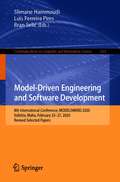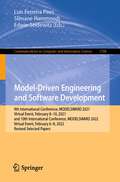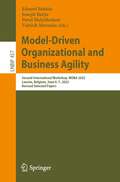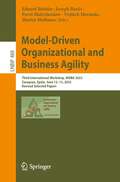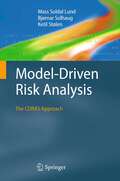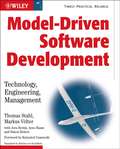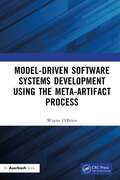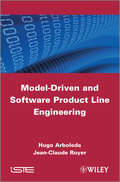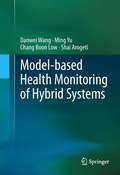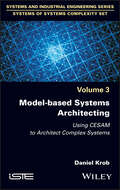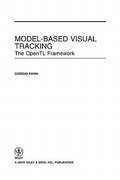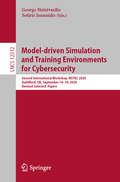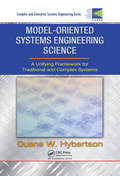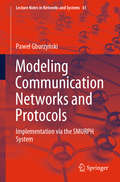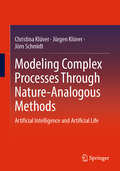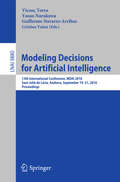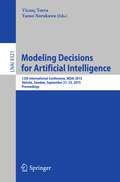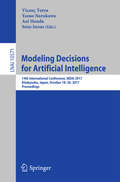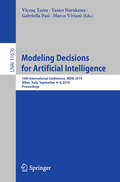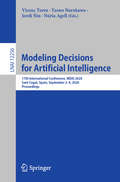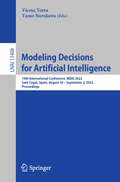- Table View
- List View
Model-Driven Engineering and Software Development: 8th International Conference, MODELSWARD 2020, Valletta, Malta, February 25–27, 2020, Revised Selected Papers (Communications in Computer and Information Science #1361)
by Slimane Hammoudi Luís Ferreira Pires Bran SelićThis book constitutes thoroughly revised and selected papers from the 8th International Conference on Model-Driven Engineering and Software Development, MODELSWARD 2020, held in Valletta, Malta, in February 2020. The 15 revised and extended papers presented in this volume were carefully reviewed and selected from 66 submissions. They present recent research results and development activities in using models and model driven engineering techniques for software development. The papers are organized in topical sections on methodologies, processes and platforms; applications and software development; modeling languages, tools and architectures.
Model-Driven Engineering and Software Development: 9th International Conference, MODELSWARD 2021, Virtual Event, February 8–10, 2021, and 10th International Conference, MODELSWARD 2022, Virtual Event, February 6–8, 2022, Revised Selected Papers (Communications in Computer and Information Science #1708)
by Slimane Hammoudi Luís Ferreira Pires Edwin SeidewitzThis book constitutes the refereed post-proceedings of the 9th International Conference and 10th International Conference on Model-Driven Engineering and Software Development, MODELSWARD 2021 and MODELSWARD 2022, was held virtually due to the COVID-19 crisis on February 8–10, 2021 and February 6–8, 2022.The 11 full papers included in this book were carefully reviewed and selected from 121 submissions. The purpose of the International Conference on model-driven engineering and software development is to provide a platform for researchers, engineers, academics as well as industrial professionals from all over the world to present their research results and development activities in using models and model driven engineering techniques for system development.
Model-Driven Organizational and Business Agility: Second International Workshop, MOBA 2022, Leuven, Belgium, June 6–7, 2022, Revised Selected Papers (Lecture Notes in Business Information Processing #457)
by Eduard Babkin Joseph Barjis Pavel Malyzhenkov Vojtěch MerunkaThis book constitutes the proceedings of the Second International Workshop on Model-Driven Organizational and Business Agility, MOBA 2022, which took place in Leuven, Belgium, in June 2022.MOBA was launched with the purpose of fetching scientific rigor into the agile practice within an entire enterprise, especially focusing on the role of models and modeling. The 10 papers presented in this volume were carefully reviewed and selected from 22 submissions. They cover topics like business intelligence, agile business rules, agile software development, adaptive domain-specific interfaces, or reconfigurable software architectures.
Model-Driven Organizational and Business Agility: Third International Workshop, MOBA 2023, Zaragoza, Spain, June 12–13, 2023, Revised Selected Papers (Lecture Notes in Business Information Processing #488)
by Eduard Babkin Joseph Barjis Martin Molhanec Pavel Malyzhenkov Vojtěch MerunkaThis book constitutes the proceedings of the Third International Workshop on Model-Driven Organizational and Business Agility, MOBA 2023, which took place in Zaragoza, Spain, in June 2023. MOBA was launched with the purpose of fetching scientific rigor into the agile practice within an entire enterprise, especially focusing on the role of models and modeling. The 9 papers presented in this volume were carefully reviewed and selected from 18 submissions. They cover topics like business intelligence, agile business rules, agile software development, adaptive domain-specific interfaces, or reconfigurable software architectures.
Model-Driven Risk Analysis: The CORAS Approach
by Ketil Stølen Bjørnar Solhaug Mass Soldal LundThe term "risk" is known from many fields, and we are used to references to contractual risk, economic risk, operational risk, legal risk, security risk, and so forth. We conduct risk analysis, using either offensive or defensive approaches to identify and assess risk. Offensive approaches are concerned with balancing potential gain against risk of investment loss, while defensive approaches are concerned with protecting assets that already exist. In this book, Lund, Solhaug and Stølen focus on defensive risk analysis, and more explicitly on a particular approach called CORAS. CORAS is a model-driven method for defensive risk analysis featuring a tool-supported modelling language specially designed to model risks. Their book serves as an introduction to risk analysis in general, including the central concepts and notions in risk analysis and their relations. The authors' aim is to support risk analysts in conducting structured and stepwise risk analysis. To this end, the book is divided into three main parts. Part I of the book introduces and demonstrates the central concepts and notation used in CORAS, and is largely example-driven. Part II gives a thorough description of the CORAS method and modelling language. After having completed this part of the book, the reader should know enough to use the method in practice. Finally, Part III addresses issues that require special attention and treatment, but still are often encountered in real-life risk analysis and for which CORAS offers helpful advice and assistance. This part also includes a short presentation of the CORAS tool support. The main target groups of the book are IT practitioners and students at graduate or undergraduate level. They will appreciate a concise introduction into the emerging field of risk analysis, supported by a sound methodology, and completed with numerous examples and detailed guidelines.
Model-Driven Software Development
by Jorn Bettin Simon Helsen Markus Völter Arno Haase Thomas Stahl Krzysztof Czarnecki Bettina Von StockflethModel-Driven Software Development (MDSD) is currently a highly regarded development paradigm among developers and researchers. With the advent of OMG's MDA and Microsoft's Software Factories, the MDSD approach has moved to the centre of the programmer's attention, becoming the focus of conferences such as OOPSLA, JAOO and OOP.MDSD is about using domain-specific languages to create models that express application structure or behaviour in an efficient and domain-specific way. These models are subsequently transformed into executable code by a sequence of model transformations.This practical guide for software architects and developers is peppered with practical examples and extensive case studies. International experts deliver:* A comprehensive overview of MDSD and how it relates to industry standards such as MDA and Software Factories.* Technical details on meta modeling, DSL construction, model-to-model and model-to-code transformations, and software architecture.* Invaluable insight into the software development process, plus engineering issues such as versioning, testing and product line engineering.* Essential management knowledge covering economic and organizational topics, from a global perspective.Get started and benefit from some practical support along the way!
Model-Driven Software Systems Development Using the Meta-Artifact Process
by Wayne O'BrienThe importance of architecture for software systems is widely accepted, but the role of architecture in the overall development process is not so clear. Presenting an architecture-centric process, Model-Driven Software Systems Development Using the Meta-Artifact Process makes the role of architecture clear. At its core, this book is about developing software systems and, more specifically, software code. It describes three major innovations for making software, which are combined with five widely used enabling technologies, to provide a complete, hypothesis-driven software development process known as Meta-Artifact Process (MAP). Having complete requirements is essential for making good software and supports the hypothesis-driven MAP.MAP offers properties, qualities, and capabilities that help stakeholders and developers understand and reason about a domain and target systems of interest. MAP, through the central role of the Meta-Artifact and incorporating the view that a computer program is a hypothesis about the requirements, offers new ways to look at systems and their development, even changing the roles of developers and stakeholders.Recommending agile methods wherever appropriate while supporting the OMG Essence standard and working within an overarching architecture, MAP presents ways to ensure that the requirements are complete and correct. It helps to identify likely points during development to form alternative hypotheses about them. Because MAP requires an underlying software development process, it can provide that clarity to existing processes in which the organization’s developers are already proficient.This book provides concrete examples from two broad but diverse areas—Accounting Information Systems in the commercial area and a military command and control system—to show the wide applicability of MAP in both commercial and defense domains.
Model-Driven and Software Product Line Engineering
by Jean-Claude Royer Hugo ArboledaMany approaches to creating Software Product Lines have emerged that are based on Model-Driven Engineering. This book introduces both Software Product Lines and Model-Driven Engineering, which have separate success stories in industry, and focuses on the practical combination of them. It describes the challenges and benefits of merging these two software development trends and provides the reader with a novel approach and practical mechanisms to improve software development productivity.The book is aimed at engineers and students who wish to understand and apply software product lines and model-driven engineering in their activities today. The concepts and methods are illustrated with two product line examples: the classic smart-home systems and a collection manager information system.
Model-Implementation Fidelity in Cyber Physical System Design
by Anca Molnos Christian FabreThis book puts in focus various techniques for checking modeling fidelity of Cyber Physical Systems (CPS), with respect to the physical world they represent. The authors' present modeling and analysis techniques representing different communities, from very different angles, discuss their possible interactions, and discuss the commonalities and differences between their practices. Coverage includes model driven development, resource-driven development, statistical analysis, proofs of simulator implementation, compiler construction, power/temperature modeling of digital devices, high-level performance analysis, and code/device certification. Several industrial contexts are covered, including modeling of computing and communication, proof architectures models and statistical based validation techniques.
Model-based Health Monitoring of Hybrid Systems
by Shai Arogeti Danwei Wang Chang Boon Low Ming YuThis book systematically presents a comprehensive framework and effective techniques for in-depth analysis, clear design procedure, and efficient implementation of diagnosis and prognosis algorithms for hybrid systems. It offers an overview of the fundamentals of diagnosis\prognosis and hybrid bond graph modeling. This book also describes hybrid bond graph-based quantitative fault detection, isolation and estimation. Moreover, it also presents strategies to track the system mode and predict the remaining useful life under multiple fault condition. A real world complex hybrid system--a vehicle steering control system--is studied using the developed fault diagnosis methods to show practical significance. Readers of this book will benefit from easy-to-understand fundamentals of bond graph models, concepts of health monitoring, fault diagnosis and failure prognosis, as well as hybrid systems. The reader will gain knowledge of fault detection and isolation in complex systems including those with hybrid nature, and will learn state-of-the-art developments in theory and technologies of fault diagnosis and failure prognosis for complex systems.
Model-based Systems Architecting: Using CESAM to Architect Complex Systems
by Daniel KrobModel-based Systems Architecting is a key tool for designing complex industrial systems. It is dedicated to the working systems architects, engineers and modelers, in order to help them master the complex integrated systems that they are dealing with in their day-to-day professional lives. It presents the CESAMES Systems Architecting Method (CESAM), a systems architecting and modeling framework which has been developed since 2003 in close interaction with many leading industrial companies, providing rigorous and unambiguous semantics for all classical systems architecture concepts. This approach is practically robust and easy-to-use: during the last decade, it was deployed in more than 2,000 real system development projects within the industry, and distributed to around 10,000 engineers around the globe.
Model-based Visual Tracking
by Giorgio PaninThis book has two main goals: to provide a unifed and structured overview of this growing field, as well as to propose a corresponding software framework, the OpenTL library, developed by the author and his working group at TUM-Informatik.The main objective of this work is to show, how most real-world application scenarios can be naturally cast into a common description vocabulary, and therefore implemented and tested in a fully modular and scalable way, through the defnition of a layered, object-oriented software architecture.The resulting architecture covers in a seamless way all processing levels, from raw data acquisition up to model-based object detection and sequential localization, and defines, at the application level, what we call the tracking pipeline. Within this framework, extensive use of graphics hardware (GPU computing) as well as distributed processing, allows real-time performances for complex models and sensory systems.
Model-driven Simulation and Training Environments for Cybersecurity: Second International Workshop, MSTEC 2020, Guildford, UK, September 14–18, 2020, Revised Selected Papers (Lecture Notes in Computer Science #12512)
by Sotiris Ioannidis George HatzivasilisThis book constitutes the refereed post-conference proceedings of the Second International Workshop on Model-Driven Simulation and Training Environments for Cybersecurity, MSTEC 2020, held in Guildford, UK, in September 2020 in conjunction with the 24th European Symposium on Research in Computer Security, ESORICS 2020. The conference was held virtually due to the COVID-19 pandemic. The MSTEC Workshop received 20 submissions from which 10 full papers were selected for presentation. The papers are grouped in thematically on: cyber security training modelling; serious games; emulation & simulation studies; attacks; security policies.
Model-oriented Systems Engineering Science: A Unifying Framework for Traditional and Complex Systems (Complex and Enterprise Systems Engineering)
by Duane W. HybertsonSystems engineering (SE) is experiencing a significant expansion that encompasses increasingly complex systems. However, a common body of knowledge on how to apply complex systems engineering (CSE) has yet to be developed. A combination of people and other autonomous agents, crossing organization boundaries and continually changing, these hybrid sy
Modeling Biomaterials (Nečas Center Series)
by Endre Süli Josef MálekThe investigation of the role of mechanical and mechano-chemical interactions in cellular processes and tissue development is a rapidly growing research field in the life sciences and in biomedical engineering. Quantitative understanding of this important area in the study of biological systems requires the development of adequate mathematical models for the simulation of the evolution of these systems in space and time. Since expertise in various fields is necessary, this calls for a multidisciplinary approach.This edited volume connects basic physical, biological, and physiological concepts to methods for the mathematical modeling of various materials by pursuing a multiscale approach, from subcellular to organ and system level. Written by active researchers, each chapter provides a detailed introduction to a given field, illustrates various approaches to creating models, and explores recent advances and future research perspectives. Topics covered include molecular dynamics simulations of lipid membranes, phenomenological continuum mechanics of tissue growth, and translational cardiovascular modeling. Modeling Biomaterials will be a valuable resource for both non-specialists and experienced researchers from various domains of science, such as applied mathematics, biophysics, computational physiology, and medicine.
Modeling Communication Networks and Protocols: Implementation via the SMURPH System (Lecture Notes in Networks and Systems #61)
by Paweł GburzyńskiThis book provides an introduction to the software system SMURPH, comprising a programming language, its compiler, and an execution environment, for specifying communication networks and protocols and executing those specifications in virtual worlds mimicking the behavior of real-life implementations. It particularly focuses on SMURPH’s wireless modeling capabilities. Written in a manual-like fashion, it includes a comprehensive description of SMURPH functionality, as well as illustrations and case studies to aid understanding.
Modeling Complex Processes Through Nature-Analogous Methods: Artificial Intelligence and Artificial Life
by Jürgen Klüver Christina Klüver Jörn SchmidtThis book is an introduction to nature-analogous techniques and related formal methods. For each technique, application examples are provided. It covers cellular automata and Boolean networks, evolutionary algorithms, as well as simulated annealing, fuzzy methods, neural networks, and finally hybrid systems, i.e., combinations of various techniques. Based on the theory of complex dynamic systems, theoretical foundations are also presented, and the similarities of these seemingly very heterogeneous techniques are pointed out. The edition has been revised and expanded with current trends such as ChatGPT.
Modeling Decisions for Artificial Intelligence
by Guillermo Navarro-Arribas Vicenç Torra Yasuo Narukawa Cristina YañezThis volume contains papers presented at the 2nd International Conference on Modeling Decisions for Arti?cial Intelligence (MDAI 2005), held in Tsukuba, Japan, July 25-27. This conference follows MDAI 2004 (held in Barcelona, Catalonia, Spain), the proceedings of which were also published in the LNAI series (Vol. 3131). The aim of this conference was to provide a forum for researchers to discuss about theory and tools for modeling decisions, as well as applications that - compass decision-making processes and information fusion techniques. In this second edition, special focus was given to applications related to risk, security and safety. The organizers received 118 papers, from 14 di?erent countries, 40 of which are published in this volume. Each submission received at least two reviews from the Program Committee and a few external reviewers. We would like to express our gratitude to them for their work. The plenary talks presented at the conference are also included in this volume. The conference was supported by the Department of Risk Engineering of the University of Tsukuba, the Japan Society for Fuzzy Theory and Intelligent Informatics (SOFT), the Catalan Association for Arti?cial Intelligence (ACIA), the European Society for Fuzzy Logic and Technology (EUSFLAT) and the Generalitat de Catalunya (AGAUR 2004XT 0004).
Modeling Decisions for Artificial Intelligence
by Vicenç Torra Yasuo NarukawaThis book constitutes the proceedings of the 12th International Conference on Modeling Decisions for Artificial Intelligence, MDAI 2015, held in Skövde, Sweden, in September 2015. The 18 revised full papers presented were carefully reviewed and selected from 38 submissions. They discuss theory and tools for modeling decisions, as well as applications that encompass decision making processes and information fusion techniques.
Modeling Decisions for Artificial Intelligence: 14th International Conference, MDAI 2017, Kitakyushu, Japan, October 18-20, 2017, Proceedings (Lecture Notes in Computer Science #10571)
by Vicenç Torra, Yasuo Narukawa, Aoi Honda and Sozo InoueThis book constitutes the proceedings of the 14th International Conference on Modeling Decisions for Artificial Intelligence, MDAI 2017, held in Kitakyushu, Japan, in October 2017.The 18 revised full papers presented together with one invited paper and three abstracts of invited talks were carefully reviewed and selected from 30 submissions. Providing a forum for researchers to discuss models for decision and information fusion (aggregation operators) and their applications to AI, the papers are organized in topical sections on aggregation operators, fuzzy measures and integrals; clustering and classication; data privacy and security; data mining and applications.
Modeling Decisions for Artificial Intelligence: 15th International Conference, MDAI 2018, Mallorca, Spain, October 15–18, 2018, Proceedings (Lecture Notes in Computer Science #11144)
by Vicenç Torra Yasuo Narukawa Isabel Aguiló Manuel González-HidalgoThis book constitutes the proceedings of the 15th International Conference on Modeling Decisions for Artificial Intelligence, MDAI 2018, held in Mallorca, Spain, in October 2018.The 24 papers presented in this volume were carefully reviewed and selected from 43 submissions. The book also contains one invited talk in full paper length. The papers were organized in topical sections named: aggregation operators, fuzzy measures and integrals; decision making; clustering and classification; and data privacy and security.
Modeling Decisions for Artificial Intelligence: 16th International Conference, MDAI 2019, Milan, Italy, September 4–6, 2019, Proceedings (Lecture Notes in Computer Science #11676)
by Vicenç Torra Yasuo Narukawa Gabriella Pasi Marco VivianiThis book constitutes the refereed proceedings of the 16th International Conference on Modeling Decisions for Artificial Intelligence, MDAI 2019, held in Milan, Italy, in September 2019. The 30 papers presented in this volume were carefully reviewed and selected from 50 submissions. They discuss different facets of decision processes in a broad sense and present research in data science, data privacy, aggregation functions, human decision making, graphs and social networks, and recommendation and search. The papers are organized in the following topical sections: aggregation operators and decision making; data science and data mining; and data privacy and security.
Modeling Decisions for Artificial Intelligence: 17th International Conference, MDAI 2020, Sant Cugat, Spain, September 2–4, 2020, Proceedings (Lecture Notes in Computer Science #12256)
by Jordi Nin Vicenç Torra Yasuo Narukawa Núria AgellThis book constitutes the refereed proceedings of the 17th International Conference on Modeling Decisions for Artificial Intelligence, MDAI 2020, held in Sant Cugat, Spain, in September 2020.* The 24 papers presented in this volume were carefully reviewed and selected from 46 submissions. They discuss different facets of decision processes in a broad sense and present research in data science, data privacy, aggregation functions, human decision making, graphs and social networks, and recommendation and search. The papers are organized in the following topical sections: aggregation operators and decision making, and data science and data mining. * The conference was canceled due to the COVID-19 pandemic.
Modeling Decisions for Artificial Intelligence: 18th International Conference, MDAI 2021, Umeå, Sweden, September 27–30, 2021, Proceedings (Lecture Notes in Computer Science #12898)
by Vicenç Torra Yasuo NarukawaThis book constitutes the refereed proceedings of the 18th International Conference on Modeling Decisions for Artificial Intelligence, MDAI 2021, held in Umeå, Sweden, in September 2021.* The 24 papers presented in this volume were carefully reviewed and selected from 50 submissions. Additionally, 3 invited papers were included. The papers discuss different facets of decision processes in a broad sense and present research in data science, data privacy, aggregation functions, human decision making, graphs and social networks, and recommendation and search. The papers are organized in the following topical sections: aggregation operators and decision making; approximate reasoning; machine learning; data science and data privacy. *The conference was held virtually due to the COVID-19 pandemic.
Modeling Decisions for Artificial Intelligence: 19th International Conference, MDAI 2022, Sant Cugat, Spain, August 30 – September 2, 2022, Proceedings (Lecture Notes in Computer Science #13408)
by Vicenç Torra Yasuo NarukawaThis book constitutes the refereed proceedings of the 19th International Conference on Modeling Decisions for Artificial Intelligence, MDAI 2022, held in Sant Cugat, Spain, during August - September 2022.The 16 papers presented in this volume were carefully reviewed and selected from 41 submissions. The papers discuss different facets of decision processes in a broad sense and present research in data science, machine learning, data privacy, aggregation functions, human decision-making, graphs and social networks, and recommendation and search. They were organized in topical sections as follows: Decision making and uncertainty; Data privacy; Machine Learning and data science.
